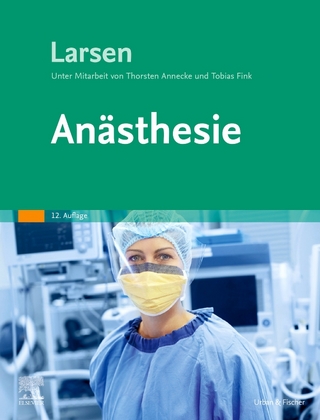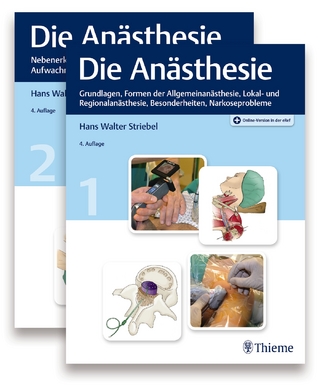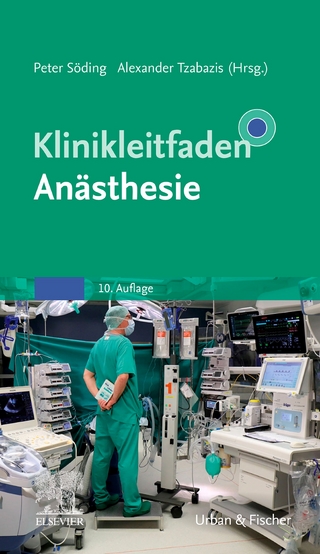
Muscle Relaxants
Springer Verlag, Japan
978-4-431-70168-2 (ISBN)
- Titel ist leider vergriffen;
keine Neuauflage - Artikel merken
At the Fifth International Neuromuscular Meeting held in Tokyo in 1994, leading experts in the field came together to discuss the physiology and pharmacology of neuromuscular receptor sites and neuromuscular blocking agents (NBAs). The proceedings of the meeting present a review of the history of muscle relaxants and a comprehensive examination of recent research, with a primary focus on clinical considerations. Among the topics covered by specific chapters are aspects of the neuromuscular junction (NMJ), pharmacokinetics, metabolism and metabolites of neuromuscular blocking agents, and drug interaction. Presenting the most up-to-date knowledge of the physiology and pharmacology of the NMJ and NBAs, this volume will be highly valuable to clinicians and researchers in anesthesiology, physiology, and pharmacology.
1. History of Muscle Relaxants.- Some Early Approaches to Relaxation in the United Kingdom.- The Final Steps Leading to the Anesthetic Use of Muscle Relaxants 8/TOC>.- History of Muscle Relaxants in Japan.- 2. The Neuromuscular Junctions - Update.- Mechanisms of Action of Reversal Agents.- Nicotinic Recentors.- The Neuromuscular Junction - Basic Receptor Pharmacology.- Muscle Contraction and Calcium Ion.- 3. Current Basic Experimental Works Related to Neuromuscular Blockade in Present and Future.- Preiunctional Actions of Neuromuscular Blocking Drugs.- Approaches to Short-Acting Neuromuscular Blocking Agents.- Effects Other than Relaxation of Non-Depolarizing Muscle Relaxants.- Regulation of Innervation-Related Properties of Cultured Skeletal Muscle Cells by Transmitter and Co-Transmitters.- 4. Current Clinical Experimental Works Related to Neuromuscular Blockade in Present and Future.- Where Should Experimental Works Be Conducted?.- Muscle Relaxants in the Intensive Care Unit.- New Relaxants in the Operating Room.- Kinetic-Dynamic Modelling of Neuromuscular Blockade.- 5. Basic Aspects of Neuromuscular Junction.- Physiology of the Neuromuscular Junction.- Properties of ?7-Containing Acetylcholine Receptors and Their Expression in Both Neurons and Muscle.- Molecular Biology of Neuromuscular Transmission.- Presynaptic Neuromuscular Blockade.- The Function of the ACh Receptor Channel.- 6. Onset of Action.- Differences of Onset of Different Muscles in Man and Their Consequences on Monitoring of Neuromuscular Transmission.- Structure-Onset Relationship of Steroidal Neuromuscular Blocking Agents.- A Blueprint for a Fast Acting Non-Depolarizing Drug.- 7. Relaxants in ICU.- Benzylisoquinolinium Compounds in the Critically Ill Patient.- The Long-Term Use of Pipecuronium in Cardiac and Esophageal Surgery Patients.- Mechanisms - Changes Induced by Long-Term High-Dose Muscle Relaxant Administration.- 8. Pharmacokinetics, Metabolism, and Metabolites.- Metabolism and Metabolites of Benzylisoquinolinium Diester Compounds.- Conceptual Building Blocks in Developing a Pharmacodynamic Model for a Muscle Relaxant.- Structure-Pharmacokinetic and Pharmacodynamic Relationships of Steroidal Neuromuscular Blocking Agents.- Pharmacokinetics and Pharmacodynamics of Aminosteroidal Neuromuscular Blocking Agents and Their Metabolites.- 9. Uses in Special Groups.- Pharmacokinetics of Muscle Relaxants in Children.- Muscle Relaxants in Elderly Patients.- Muscle Relaxants in patients with Renal or Hepatic Failure.- The Influence of Temperature on the Adductor Pollicis Twitch Tension in the Presence and Absence of Vecuronium.- 10. Monitoring.- The Iceberg Theory - Fact or Fiction? Implication for Monitoring.- New Aspects of Double Burst Stimulation.- 11. Drug Interactions.- Interactions of Volatile Anesthetics with Non-Depolarizing Neuromuscular Blocking Agents.- Interaction Between Calcium Antagonists and Muscle Relaxants.- Dexamethasone Induces nAChRs Upregulation in C2C12 Mouse Myotubes.- Interaction Between Muscle Relaxants.- 12. Methods of Administration.- The Pharmacokinetics of the Three Isomers of Mivacurium Chloride in Healthy, Renal and Hepatic Patients Given Short or Prolonged Infusions of the Drug.- Methods of Administration of Neuromuscular Blocking Drugs.- Pharmacodynamics and Pharmacokinetics of Different Modes of Rocuronium Administration.- Making the Administration Simple and Safe.- 13. Reversal of Blockade.- Problems with Reversal in Adults.- Ventilation and Neuromuscular Blocking Drugs.- Reversal of Mivacurium: Neostigmine, Edrophonium, or Spontaneous Recovery - Which Makes More Sense?.- Anticholinesterase Agents: An Odyssey.- 14. Future of Muscle Relaxants.- Future Goals of the Benzylisoquinolinium Ester Program.- Is a Non-Depolarising Suxamethonium an Achievable Target?.- The Future of Muscle Relaxants Outside the Operating Room.- 15. Scientific Presentations.- Recovery Characteristics After Early Administration of Anticholinesterases During Intense Mivacurium-Induced Block.- Assessment of the Optimal Interval of Tetanic Stimulation for Post-Tetanic Count.- Clinical Assessment of a New Neuromuscular Monitoring System: TOF Guard(R) - A Comparison with the Conventional Method.- Onset and Duration of Rocuronium and Succinylcholine at the Adductor Pollicis and Laryngeal Adductor Muscles in Patients Anesthetized with Fentanyl and Propofol.- The Mechanisms of the Differential Sensitivity to Non-Depolarizing Muscle Relaxants of the Adductor and Abductor Laryngeal Muscles in Rat.- Rocuronium Neuromuscular Blockade at Guinea Pig Intrinsic Laryngeal Muscles and the Cranial Tibial Muscle.- Fibers, Endplates and Acetylcholine Receptors in Limb, Abdominal, Laryngeal and Diaphragm Muscles in the Cat.- Recovery and Reversal of Mivacurium Neuromuscular Blockade with Neostigmine and Edrophonium in Paediatric Patients.- Neuromuscular Effects of Mivacurium When Preceded by Succinylcholine in Children.- Isobolographic Analysis of the Interaction Between Hexamethonium and Decamethonium.- Synergism Between Atracurium and Vecuronium with Mivacurium.- Influence of Bambuterol on the Duration of Action of Mivacurium Induced Neuromuscular Blockade.- Onsets of Train-of-Four Responses and Discomfort Associated With the Ulnar Nerve Stimuli at Varying Currents.- A Method for Studying Interaction Between Non-Deporalizing Neuromuscular Blockers and Other Drugs in Vivo.- Time Course of Neuromuscular Block of Vecuronium Analogues and d-Tubocurarine in the Chick Biventer Cervicis Muscle.- Female Rats are More Sensitive to the Neuromuscular Blocking Action of Rocuronium than Male Rats.- The Effect of Cardiac Output on the Onset of Neuromuscular Blockade of Vecuronium and Pancuronium.- Correlation of the Speed of Onset of the Effective Relaxation with Vecuronium 0.15 mg/kg with Body Mass and the Size of the Priming Dose.- Functional Heterogeneity of Murine Mucosal and Connective Tissue Mast Cells in Response to Six Kinds of Muscle Relaxants in Vitro.- Hemodynamic Evaluation of Pancuronium Bromide by the Transesophageal Echocardiography.- Neuromuscular Blocking Effects of Org-9487 in the in Vitro Rat Hemidiaphragm/phrenic Nerve Preparation.- Neuromuscular Refractoriness, Prejunctional Block and MgSO4 in the Pig.- Comparative Studies of Pipecuronium and Tubocurarine on Releases of Histamine and N-Methylhistamine in Surgical Patients.- The Effects of Rocuronium in Infants, Children and Adults.- Augmentation of Succinylcholine on the Neuromuscular Blocking Effect of Vecuronium in Pediatrics.- Efficient Method for Administration of Neostigmine to Antagonize Neuromuscular Blockade by Vecuronium.- Antagonism of Mivacurium-Induced Neuromuscular Blockade in Man: Edrophonium Dose Requirements at Threshold Train-of-Four Count of Four.- Edrophonium Antagonism of Constant Mivacurium Infusion.- Comparison of the Neuromuscular Effects of SZ1676, SZ1677 and Vecuronium in Beagle Dogs.- The Protein Binding of SZ1676, SZ1677 and Rocuronium and Their Inhibitory Effect on Human Cholinesterases.- Comparison of the Neuromuscular Effects of SZ1676 and Vecuronium in Guinea-Pig.- Postsynaptic Nicotinic Receptor Desensitized by Non-Contractile Ca2+ Mobilization (Ramic) via Protein Kinase-C Activation at the Mouse Neuromuscular Junction.- The Influence of Cold on the Recovery Index of Vecuronium and Decamethonium in Man.- Discrepancy of Recovery Times Related to Potency Between Atracurium and Mivacurium Simultaneously Administered into the Isolated Forearms.- Disposition of Mivacurium Isomers in Patients Undergoing Hypothermic Cardiopulmonary Bypass.- The Duration of Vecuronium Action Shortened After Kidney Transplantation.- Evaluation of 51W89 for Endotracheal Intubation and Repeated Doses.- A New Technique for the Facilitation of Rapid Sequence Intubation: "The Prime Time Principle".- Pharmacodynamics of Pipecuronium in Patients with Decreased Renal Function.- The Sensitivity of the Neonatal Rat to Mivacurium Relative to Mature Rats.- The Effects of Sevoflurane, Halothane and Balanced Anaesthesia on Vecuronium-Induced Neuromuscular Blockade in Children.- The Effects of Succinylcholine-Induced Fasciculation on Energy Metabolism in Rat Denervated Skeletal Muscle Studied by 31P-NMR.- The Potency and Time Course of the Neuromuscular Effects of SZ1676 and Its Hydroxy Analogs in Guinea-Pigs.- Comparison of the Neuromuscular and Circulatory Effects of SZ1676, SZ1677 and Rocuronium in Cats.- Comparative Pharmacodynamics of SZ1677 and Rocuronium in Laryngeal Muscles of the Guinea Pig.- Do Antiarrhythmic Dose of Magnesium Have Prejunctional Neuromuscular Block in Human Being.- The Roles of the Equilibrium Dissociation Constant and the Receptor Concentration on the Time Course of Neuromuscular Block.- Safety and Efficacy of Surgeon-Controlled Mivacurium Administration During Elective Caesarean Section.- Dose Response Relationship of Mivacurium in Patients Homozygous for the Atypical Cholinesterase Gene.- Hyperparathyroidism in Patients with Chronic Renal Failure Shortens the Action of Vecuronium.- Mivacurium-Induced Neuromuscular Blockade (NB) Is Not Affected by Chronic Anticonvulsant Therapy with Carbamazepine.- Does Chronic Anticonvulsant Therapy with Carbamazepine Affect the Atracurium Induced Neuromuscular Blockade?.- An Anesthesia for the Patient Who Was Suspected the Lambert-Eaton Syndrome by an Unexpected Prolongation of Vecuronium.- Quantifying the Effect of Enflurane on Infusion Requirements of Atracurium and Vecuronium.- Effect of Isoflurane and Sevoflurane on the Potencies of the Neuromuscular Blocking Agents in Rat in Vivo.- Comparative Neuromuscular Inhibition of Volatile Anesthetics Using Repetitive Stimulation.- Potentiation of Vecuronium by Desflurane vs. Isoflurane.- Neuromuscular Recovery During Washout of Desflurane vs. Isoflurane.- Pharmacodynamics of Rocuronium in Comparison with that of Vecuronium.- Co-Administration of Two Muscle Relaxants: When Are the Effects Supra-Additive?.- Neuromuscular Interaction Between Succinylcholine and Esmolol in the Rat.- Intubating Conditions and Haemodynamic Effects of Rapid Sequence Induction with Fentanyl, Propofol and Rocuronium.- The Usefulness of Neuromuscular Monitoring in the Intensive Care Unit - A Report of Three Cases.- Comparison of Respiratory Sparing Effect on Pancuronium, Vecuronium and Rocuronium in Rats in Vivo.- Difference of Recovery of Neuromuscular Function in Adductor Pollicis and Flexor Hallucis Brevis Following Muscle Relaxation with Vecuronium.
| Erscheint lt. Verlag | 31.12.1995 |
|---|---|
| Zusatzinfo | biography |
| Verlagsort | Tokyo |
| Sprache | englisch |
| Gewicht | 815 g |
| Einbandart | gebunden |
| Themenwelt | Medizin / Pharmazie ► Medizinische Fachgebiete ► Anästhesie |
| Medizin / Pharmazie ► Medizinische Fachgebiete ► Notfallmedizin | |
| Medizin / Pharmazie ► Medizinische Fachgebiete ► Pharmakologie / Pharmakotherapie | |
| ISBN-10 | 4-431-70168-0 / 4431701680 |
| ISBN-13 | 978-4-431-70168-2 / 9784431701682 |
| Zustand | Neuware |
| Haben Sie eine Frage zum Produkt? |
aus dem Bereich


